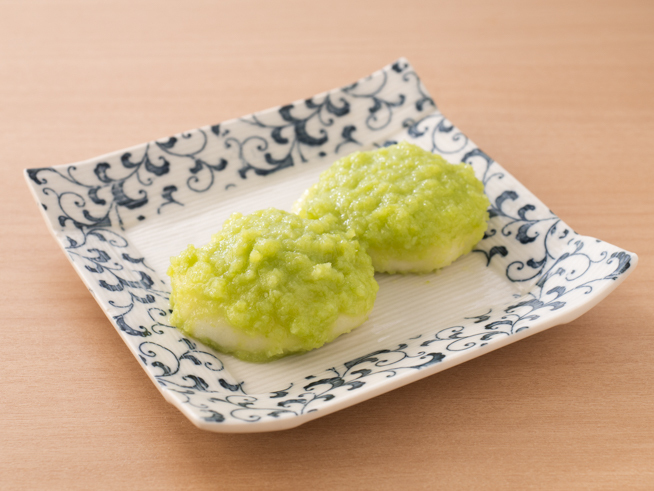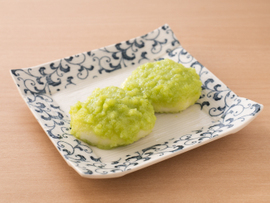
Zunda

MiyagiZunda
Classification (Large)
Agricultural products
Classification (Small)
Grain products
Main ingredients used
soybeans, sugar, salt
When using downloaded images, please read the "Terms of Use" and clearly state that the source of the image is "Traditional Foods in Japan" by the Ministry of Agriculture, Forestry and Fisheries.
If the photo credits is stated, please include it as well.
Example of description
of the photo credits
Example of description when the photo credits is not stated
Source: "Traditional Foods in Japan" Ministry of Agriculture, Forestry and Fisheries
Example of description when the photo credits is stated
Source: "Traditional Foods in Japan" Ministry of Agriculture, Forestry and Fisheries
Photo credits:xxx
Region of inheritance
Prefecture-wide
Product overview (special characteristics and types)
Zunda is created by boiling edamame, removing the thin skins, and mashing the beans. Add sugar and a pinch of salt and mix it for a paste that is topped on freshly pounded rice cakes to create one of Miyagi Prefecture’s most famous dishes, zunda mochi. Zunda mochi is one of the three major delicacies of Miyagi Prefecture, along with sasa-kamaboko and beef tongue. The contrast between the vibrant green bean paste and shiny, smooth, white mochi is beautiful and mouth-watering. Zunda’s mild sweetness, bean flavor, and slightly chunky texture create an exquisite balance with the chewy mochi.
There have traditionally been many opportunities to eat mochi in Miyagi Prefecture, and it has always been eaten at various yearly events, such as at New Year’s, weddings, memorial services, and funerals. As a result, diverse types of mochi dishes were born, including fusube mochi, which uses crisp, roasted loach, kurumi mochi, goma mochi, and natto mochi. Of these variations, zunda mochi, created with edamame harvested in summer, is often presented as offerings for the Obon festival and the equinoctial week, along with being used as food for guests.
Since the olden days, zunda mochi has been treasured as a nutritional food during the summer, when the heat causes people to lose their appetite. Edamame nutrients, such as vitamin B1 and B2, are said to boost energy metabolism and provide support for recovery from fatigue.
History and culture
The history of zunda is a long one, dating back more than 500 years to the Sengoku period. There are many theories on the origin of its name. One theory says that Date Masamune mashed edamame with the handle of his jindachi sword to eat at a military camp during battle, which evolved to be called zunda. Another theory says that a farmer named [Jinda], who was living in the territory of the Sendai clan, mashed edamame and mixed it with mochi. Those who saw this called the dish jinda mochi, which evolved to become zunda mochi. There is no hard evidence for either of these theories. Regions that eat this zunda mochi are often in the area of Oshu, which was the territory of Date Masamune, but the dish is also common in the Tohoku region. It is said that the sweet-flavored zunda mochi eaten today came to be at the end of the Edo period.
In the past, zunda mochi could only be made during the edamame season of July to September. However, in modern times, thanks to the development of automatic shelling machines and freezing technologies, we can enjoy this dish all year round. Furthermore, it has become famous country-wide as a Miyagi Prefecture delicacy, and is often purchased as a souvenir by tourists.
It is said that the reason zunda is still a beloved local dish of Miyagi is because of its connection with the history of Date Masamune.
Production method
To create zunda, edamame is boiled until it is soft and its thin skin is removed, then the edamame is mashed to a chunky texture. Adding sugar and a pinch of salt before mixing and creating a bean paste to top on freshly pounded mochi completes the zunda mochi dish. In the past, many people made their own zunda at home, but currently, most eat zunda purchased in stores.
Furthermore, more restaurants and cafes in Miyagi Prefecture offer menu items with edamame-made zunda combined with other foods besides mochi.
Conservation and succession efforts
Zunda is sold in Miyagi Prefecture supermarkets, specialty stores, and to tourists at train stations and gift shops as a Miyagi delicacy. Menus featuring dishes using zunda, including zunda mochi, are immensely popular, and in a Sendai City tourism field study conducted in 2023, 40% of participants answered that [enjoying food] was what attracted them to Sendai City. The study also showed that women from all generations had a high ratio of having tried zunda-type foods. Zunda is loved by many generations, both within the prefecture and in other regions, by being incorporated into various dishes.
Main consumption method
Topping zunda on mochi, or zunda mochi, is the most popular dish. However, now we can also find zunda combined with various sweets, both Japanese and Western, for dishes like zunda shakes, zunda dorayaki, zunda cakes, and zunda shaved ice.
At-home recipes:Deep-fried rice-flour and zunda dumplings dressed in sesame (8 balls)

Ingredients
Rice flour for dumplings
140 g
Flour
10g
Water
150ml
Sugar (30% of the flour)
50g
Lard (5% of the flour)
8g
Zunda paste
150 g (roll into 8 balls)
Polished sesame seeds
4 tablespoons (white sesame is fine)
Frying oil (oil absorption ratio 5%)
How to make
Crush the rice flour into a powder and mix with flour. Add water and sugar, and boil down until the temperature reaches 170°C. Add lard and set aside to cool. Make eight balls out of the zunda paste. Prepare a tray with polished sesame seeds.
Add the sugar-water with the rice flour and mix well. Shape into a bar and cut into eight pieces. Roll up one piece and flatten into a circular shape 7 to 8 cm in diameter, with a thinner circumference and thicker center. Place the zunda paste in the center and wrap.
Dress the rolled-up dumpling with polished sesame seeds and deep-fry.
How to deep-fry the dumplings Place the dumplings into oil heated to 140°C. At first, move the dumplings around with chopsticks to make sure that the sides touching the bottom of the pot do not burn. Slowly turn up the heat and deep-fry for approximately 10 minutes until the dumplings start to float. Adjust it so that the temperature is 170°C around the time the dumplings are done being fried. Temperatures higher than this will cause the sesame seeds to burn and will make the dumplings crack.
(Recipes and photos) Makiko Takazawa

